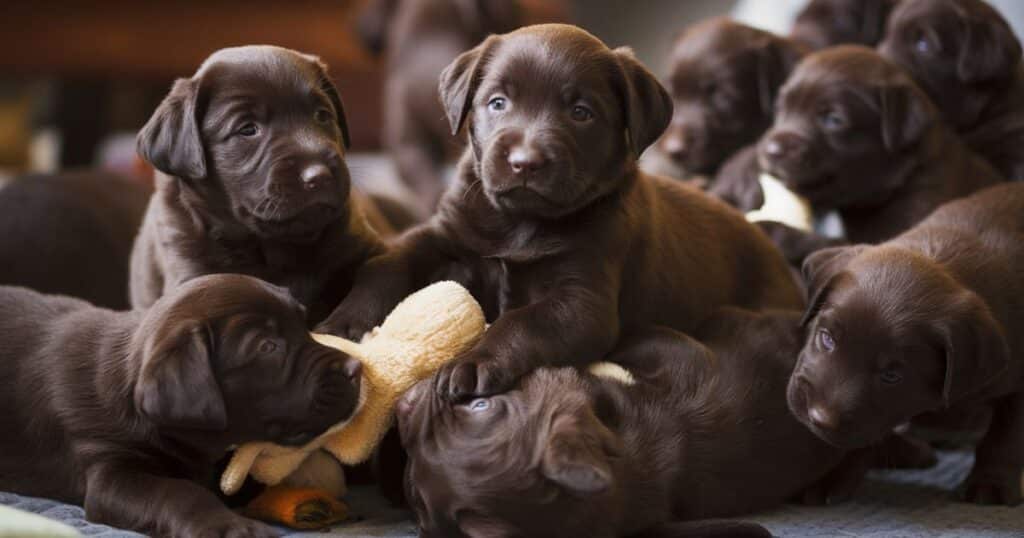The chocolate Labrador Retriever puppy a bundle of joy that melts hearts with its rich, velvety coat and those puppy dog eyes you just can’t resist. These little social butterflies are truly global appeal magnets, captivating dog lovers worldwide with their curious nature and endearing antics. In this comprehensive guide, we’ll dive into everything you need to know about raising one of these lovable, energetic fur babies from puppyhood to their golden years.
Bringing home a chocolate Lab puppy is more than just adding a new pet to your family, it’s embarking on a journey filled with endless adventures, precious memories, and an unbreakable bond that will forever change your life. These pups are the epitome of curiosity, always eager to explore the world around them and soak up new experiences like tiny sponges.
So, get ready to fall head over heels for these little explorers as we unravel the secrets to providing them with the best possible care, from their newborn phase to their twilight years.
The Fascinating Origins of the Chocolate Lab
While chocolate Labs may seem like a relatively modern phenomenon, their roots can be traced back centuries. The Labrador breed itself originated in the Canadian province of Newfoundland, where these versatile dogs were bred to assist fishermen with their arduous tasks, such as retrieving ropes and hauling in nets.
It wasn’t until the 19th century that the Labrador origin story took an intriguing turn. Through a series of cross-breedings and selective breeding programs, a unique variation emerged, the chocolate Labrador Retriever. This distinct coat color quickly captured the hearts of dog enthusiasts and set the stage for the breed’s meteoric rise in popularity.
Unraveling the Genetic Mysteries of Chocolate Labs
Did you know that the chocolate coat color is the result of a rare genetic variation? It’s a recessive trait, meaning that both parents must carry the chocolate gene for their offspring to inherit the stunning hue. This genetic quirk is what makes chocolate Labradors one of the rarest shades within the breed.
But the intrigue doesn’t stop there. Some experts suggest that chocolate Labs may have slightly different temperaments and personalities compared to their black and yellow counterparts. While more research is needed in this area, it’s an intriguing theory that adds to the allure of these unique pups.
ALSO READ: The Unique Dudley Labrador: A Comprehensive Guide
Preparing for Your Chocolate Lab Puppy’s Arrival
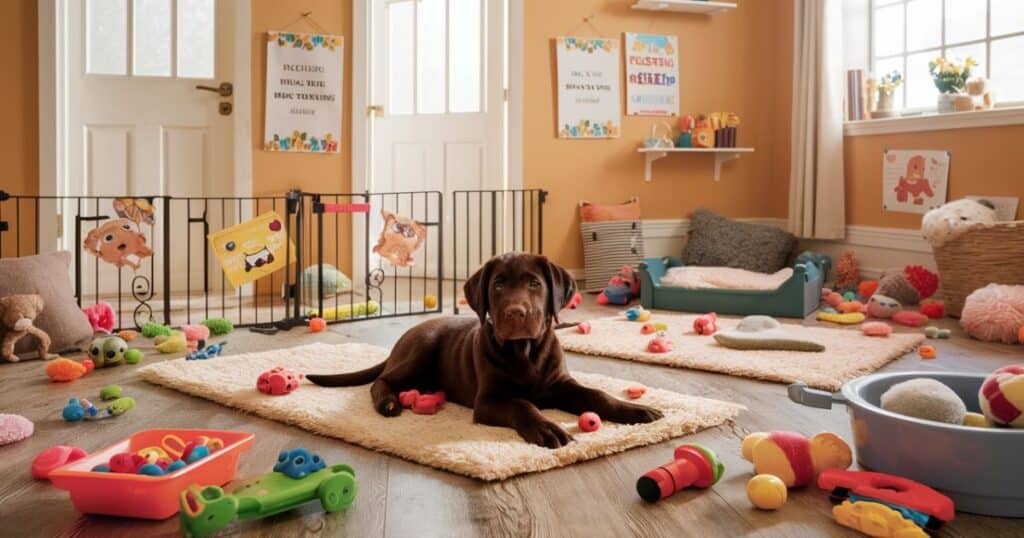
Bringing home a new puppy is an exciting journey, but it requires careful preparation to ensure a smooth transition and a safe, nurturing environment for your furry friend. In this section, we’ll guide you through the essential steps to puppy-proof your home, stock up on necessary supplies, and create the perfect ambiance for your chocolate Lab’s grand arrival.
Puppy-Proofing 101: Creating a Safe Haven
Before your chocolate Lab pup sets paw in your home, it’s crucial to identify and eliminate any potential hazards. Here’s a handy puppy-proofing checklist to ensure your space is a secure and puppy-friendly zone:
- Electrical Cords: Puppies love to chew, and exposed electrical cords can be a serious safety hazard. Use cord covers, tuck them away, or elevate them out of reach.
- Household Cleaners and Chemicals: Ensure all cleaning products, pesticides, and other toxic substances are stored securely in cabinets or on high shelves.
- Sharp Edges and Corners: Protect your pup from bumps and scratches by covering sharp furniture edges with corner guards or foam padding.
- Trash Cans: Invest in sturdy, lidded trash cans to prevent your chocolate Lab from rummaging through and potentially ingesting harmful items.
- Houseplants: Research which plants are toxic to dogs and remove them from areas accessible to your puppy.
- Small Objects: Secure or remove any small items that could pose a choking hazard, such as buttons, coins, or children’s toys.
Puppy-proofing may seem like a daunting task, but it’s an essential step in creating a safe, welcoming environment for your new furry family member.
Setting the Mood: Creating a Cozy Puppy Paradise
Ambiance matters, and creating a warm, inviting space can help your chocolate Lab puppy feel right at home from day one. Here are some quick, easy ambient hacks to try:
- Soft Lighting: Puppies can be easily startled by harsh, bright lights. Use lamps with soft bulbs or dimmers to create a calming atmosphere.
- Cozy Bedding: Provide a comfortable, plush bed or crate lined with soft blankets or pads for your pup to snuggle up in.
- Soothing Sounds: Consider playing calming music or nature sounds to help your puppy relax and feel at ease in their new surroundings.
- Familiar Scents: Bring home a blanket or toy from the breeder or shelter to help your chocolate Lab associate their new space with familiar smells.
- Puppy-Safe Plants: Add some greenery with dog-friendly plants like bamboo or money trees, which can help purify the air and create a serene vibe.
By taking the time to create a cozy, inviting puppy palace, you’ll help your chocolate Lab adjust more quickly and feel secure in their new forever home.
Nutrition Know-How for Your Chocolate Lab Pup
Proper nutrition is key to your puppy’s growth, development, and overall well-being. In this section, we’ll dive into the dietary needs of chocolate Labs, exploring the pros and cons of raw vs. kibble diets, and sharing must-have nutrients for a healthy, happy pup.
Chow Time: Fueling Your Chocolate Lab’s Growth
Chocolate Labs are active, energetic pups that require a well-balanced diet to support their rapid growth and high energy levels. Here are some essential must-have nutrients for your chocolate Lab:
- Protein: Puppies need plenty of high-quality protein from sources like chicken, turkey, or fish to support muscle development and growth.
- Fats: Healthy fats are crucial for energy, skin and coat health, and essential nutrient absorption. Look for foods containing omega-3 and omega-6 fatty acids.
- Carbohydrates: Complex carbs like brown rice, oats, and sweet potatoes provide sustained energy and fiber for proper digestion.
- Vitamins and Minerals: Calcium, phosphorus, and vitamins A, D, E, and B-complex are essential for strong bones, teeth, and overall health.
When it comes to portion sizes, it’s best to follow the recommended feeding guidelines on your puppy’s food and adjust as needed based on their activity level and growth rate.
The Raw Truth vs. Kibble Convenience: The Food Face-off
One of the most hotly debated topics in the world of dog nutrition is the raw vs. kibble dilemma.
Let’s explore the pros and cons of each:
Raw Diet
- Pros: More closely mimics a dog’s natural, ancestral diet; can provide more bioavailable nutrients; may improve digestion and dental health.
- Cons: Requires careful handling and preparation to prevent bacterial contamination; can be more expensive and time-consuming; may lack important nutrients if not properly balanced.
Kibble Diet
- Pros: Convenient, pre-portioned, and shelf-stable; often fortified with essential vitamins and minerals; less risk of bacterial contamination.
- Cons: May contain fillers, preservatives, and lower-quality ingredients; can be less digestible and less nutrient-dense than a raw diet.
Ultimately, the choice between raw and kibble is a personal one, and it’s best to consult with your veterinarian to determine the optimal diet for your chocolate Lab puppy’s specific needs.
Socializing Your Chocolate Lab: Building Confidence
Socialization is crucial for raising a well-adjusted, confident chocolate Lab. In this section, we’ll share strategies for introducing your pup to new sights, sounds, and experiences, as well as milestones to hit and perfect places for puppy socialization.
The Puppy Social Scene: Making Friends and Influencing Pups
From your backyard to the dog park and beyond, there are numerous venues perfect for socializing your chocolate Lab pup. Here are some top picks for outdoor frolics and social escapades:
- Puppy Playdates: Arrange supervised playtimes with other vaccinated puppies to help your Lab practice their social skills and make new furry friends.
- Dog Parks: Once your pup has completed their full round of vaccinations, dog parks are great for socialization, exercise, and teaching proper canine etiquette.
- Obedience Classes: Puppy training classes provide a wonderful opportunity for your chocolate Lab to have positive experiences around other dogs and people in a controlled environment.
- Nature Trails: Explore different outdoor trails and parks, allowing your pup to experience new sights, smells, and sounds in a low-stress setting.
- Pet-Friendly Stores: Many retail stores welcome well-behaved dogs, giving your chocolate Lab practice navigating new environments and meeting people calmly.
The key is to expose your puppy to as many new, positive experiences as possible during their critical socialization window between 8-16 weeks old. Keep sessions short, reward good behavior, and you’ll be setting the stage for a socially savvy adult dog.
The Heart of the Matter: Building an Unbreakable Bond
Beyond just socialization, it’s equally important to focus on strengthening the bond between you and your chocolate Lab pup. This human-canine connection will be the foundation for a lifetime of love, trust, and companionship. Here are some relationship goals to strive for:
- Unconditional Love: Shower your pup with affection, gentle pets, and quality time to foster a sense of security and devotion.
- Positive Reinforcement: Use rewards-based training methods to build confidence and a willingness to learn and please you.
- Mutual Respect: Set clear boundaries and rules, but also recognize your Lab’s needs for play, exercise, and mental stimulation.
- Teamwork: Include your pup in family activities and outings, letting them know you’re a packmates working together.
The bond you build now will pay dividends down the road, resulting in a responsive, well-mannered chocolate Lab who is always by your side.
Training Your Chocolate Lab: Obedience Made Easy
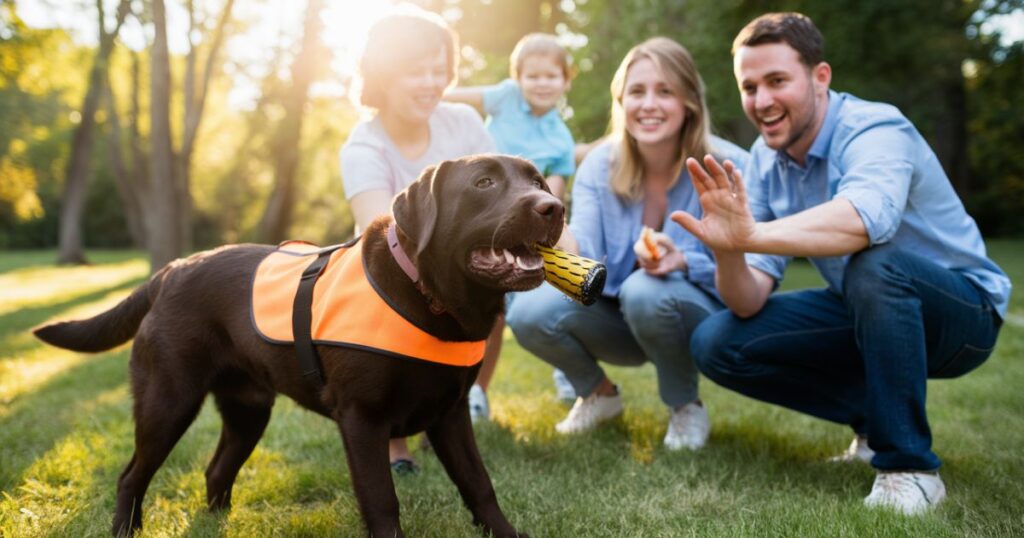
Chocolate Labs are highly intelligent and eager to please, making them quite trainable if you use positive reinforcement methods. We’ll cover basic commands every pup should know, advanced techniques, and how to identify the best rewards for your Lab.
Treats or Toys? Unlocking Your Pup’s Motivation
Different pups are motivated by different things. Some will work tirelessly for a tasty treat, while others prefer the thrill of playing with a favorite toy as their reward. Figuring out your chocolate Lab’s currency is key.
To gauge their preferences, do some reward trials offering both treats and a prized toy. See which one gets more enthusiasm and focus. You can also mix it up, rewarding occasionally with the other to keep them guessing.
Once you know if your pup is motivated more by food or play, you can better tailor your training approach using those incentives. But remember, rewards should be given judiciously and phased out as behaviors become ingrained habits.
The ABCs of Dog Commands
These are some of the core basic commands every chocolate Labrador should master:
- Sit
- Stay
- Come
- Down
- Heel
- Leave It
- Drop It
Use positive reinforcement by giving a treat and praise when they obey. Keep sessions short and upbeat. Be patient and consistent. If your pup struggles, break it down into smaller steps at first.
You’ll want to practice basic commands regularly, in different environments, so they become second nature. Once mastered, you can then move onto more advanced training.
Advanced Training Techniques for Chocolate Lab Puppies
For those looking to take their chocolate Lab’s skills to the next level, there are many exciting advanced training options to explore, from impressive party tricks to crucial off-leash obedience commands.
Advanced Skills Worth Teaching Your Chocolate Lab
Here are some fun and functional advanced skills to work on:
- Shake: A classic trick that’s cute and practical for greeting people politely.
- Roll Over: Besides entertainment value, this helps get dogs comfortable being handled.
- Fetch and Retrieve: Great for exercise and for teaching a solid “drop it” command.
- Off-Leash Obedience: Teaching reliable recall, heel, and stay regardless of distractions.
- Agility Training: Navigating obstacle courses boosts confidence and strengthens your bond.
- Nose Work/Scent Tracking: Tapping into their natural retrieving abilities in a stimulating way.
Take it step-by-step, keep sessions positive and upbeat, and remember that mental exercise is just as tiring for a pup as physical activity.
Quick Tips for Effective Advanced Training
- Break skills down into small, progressively harder steps to set your pup up for success
- Use higher value rewards like chicken or hot dogs for more challenging behaviors
- Practice in different environments once a skill is learned to proof the behavior
- Be patient and consistent – advanced skills take time to become second nature
- Make it fun by incorporating games, play breaks, and ending on a positive note
- Consider joining a training club for support, socialization, and skill seminars
With time, commitment, and an upbeat attitude, you can turn your chocolate Lab into an impressive, well-rounded canine scholar!
Grooming 101 for Chocolate Lab Puppies
That gorgeous chocolate coat requires regular maintenance to keep your Lab looking and feeling their best. We’ll share essential grooming tasks, top tools, and expert tips for taming shedding.
From Fuzzy to Fabulous: The Ultimate Grooming Guide
While their short coats are relatively low-maintenance compared to some breeds, chocolate Labs do require some regular grooming:
- Brushing (1-2 times per week): Use a slicker brush to remove loose hair and prevent matting. Brush in the direction of hair growth.
- Bathing (every 6-8 weeks): Use a mild, dog-safe shampoo and thoroughly rinse to prevent residue buildup which can dull the coat.
- Nail Trims (every 4-6 weeks): Keeping nails trimmed prevents cracking/splitting and clicking on floors. Use a nail grinder for best results.
- Ear Cleaning (weekly): Check for buildup, odor, or inflammation and wipe out with a dog-safe ear cleaner to prevent infections.
- Teeth Brushing (2-3 times per week): Regular brushing removes plaque/tartar and promotes good dental hygiene.
Be sure to get your chocolate Lab puppy comfortable with all grooming activities using treats and positive reinforcement from an early age.
Shedding Woes and How to Combat Them
While you can’t stop a double-coated breed like the Labrador from shedding completely, you can minimize the doggy clouds of fur with some key tools and techniques:
Essential Tools for Shedding
- Deshedding brush or rake
- High-velocity dryer
- Vacuum with pet hair attachment
- Lint rollers
Shedding Season Strategies
- Increase brushing frequency during heavy shed seasons
- Bathe more often to loosen dead undercoat
- Consider professional de-shedding treatments
- Supplement diet with omega fatty acids for healthy skin/coat
With some consistent effort using the right tools, you can tame your chocolate Lab’s shedding and keep your home looking fur-free(ish).
Keeping Your Chocolate Lab Healthy and Happy
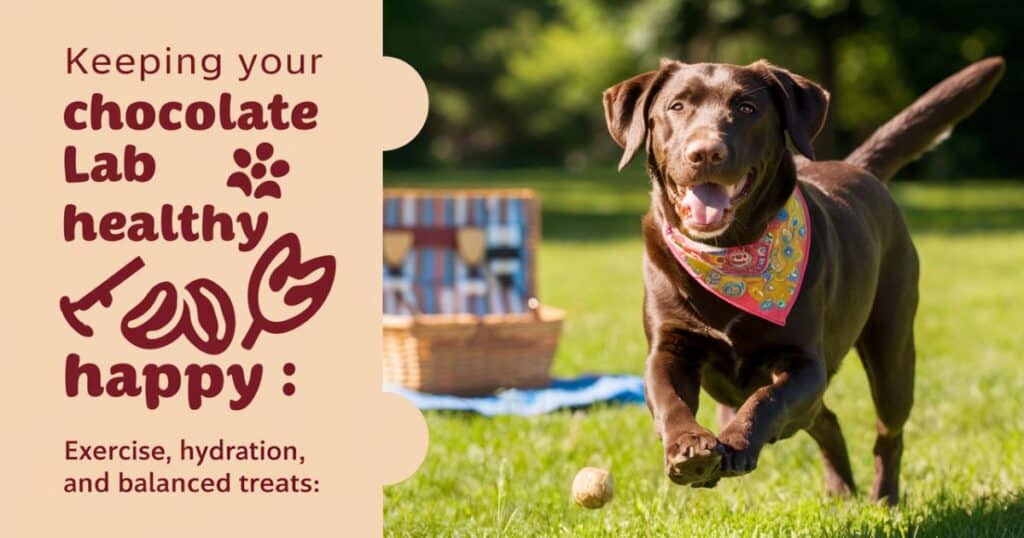
From routine vet visits to a balanced diet, we’ll cover all aspects of maintaining your chocolate Lab’s overall health and well-being throughout their lifetime.
Vet Visits Made Easy: Stress-Free Check-Ups
Regular veterinary care is crucial for catching any potential health issues early on. However, we know vet visits can be stressful for both pup and owner. Here are some tips to make these appointments a walk in the park:
✔️ Get your Lab used to being handled, having their ears/mouth checked, and being placed on an exam table with positive reinforcement training at home.
✔️ Bring high-value treats, a favorite toy, or a dog-safe peanut butter lick mat to provide a positive distraction during the visit.
✔️ Consider pheromone products like Adaptil to help relieve anxiety and promote calming.
✔️ Stay calm and upbeat yourself, as dogs can sense energy and stress from their owners.
✔️ Ask about mobile vet services or anxiety medication if your Lab has severe ph
✔️ Ask about mobile vet services or anti-anxiety medication if your Lab has severe phobias about vet visits that training can’t overcome.
With some preparation and the right positive reinforcement strategies, you can help your chocolate Lab associate the vet’s office with pleasant experiences.
The Menu Must-Haves
A balanced, nutritious diet is absolutely vital for your chocolate Lab’s overall health. Here are some dietary must-haves:
🍗 High-Quality Protein – Look for whole proteins like chicken, turkey, fish or eggs as the first ingredient to build and repair muscles.
🥦 Fruits & Vegetables – These provide essential vitamins, minerals, antioxidants and fiber. Try adding fresh or frozen produce to their meals.
🥥 Healthy Fats – Fats like those found in fish oil, coconut oil or flaxseeds provide energy, improve coat condition and cognitive function.
💧 Plenty of Fresh Water – Puppies and active dogs require constant access to clean, fresh water to stay properly hydrated.
📋 Appropriate Portions – Carefully measure portions based on your Lab’s age, weight and activity level to prevent unhealthy weight gain.
Consult your vet about any additional supplements that may benefit your chocolate Lab’s individual needs as they age.
Regular Veterinary Care for Chocolate Lab Puppies
Preventive veterinary care from puppyhood throughout your chocolate Lab’s life is one of the best investments you can make in their long-term health and wellbeing.
The Puppy Vaccination Schedule
Vaccinations are crucial for protecting your Lab puppy from potentially fatal diseases. Most vets recommend this core vaccination schedule:
- 6-8 weeks: Distemper, parvovirus, coronavirus
- 10-12 weeks: DHPP (distemper, hepatitis, parainfluenza, parvovirus)
- 14-16 weeks: Rabies
- 12-16 weeks: Bordetella (kennel cough)
Additional non-core vaccines like Lyme disease or leptospirosis may be recommended based on risk and location. Be sure to keep your puppy’s vaccines up-to-date!
Preventing Puppy Parasites
Intestinal worms like roundworms, hookworms and whipworms are extremely common in puppies. Your vet will want to deworm your chocolate Lab pup on a schedule, typically:
- 2, 4, 6 and 8 weeks old
- Then once every 3-6 months
They’ll also recommend monthly heartworm and flea/tick prevention medications to protect against these parasites.
Spaying/Neutering Your Chocolate Lab
Most vets and breeders strongly recommend spaying/neutering your chocolate Lab around 6 months old unless you plan to use them for ethical, responsible breeding purposes. Benefits include:
- Reduces risk of mammarian cancer and uterine infections in females
- Prevents testicular cancer and prostate problems in males
- Curbs marking, mounting and roaming behaviors
- Helps curb aggression in males
By keeping up with your puppy’s preventive care schedule, you’ll help set them up for a lifetime of optimal health.
Ethical Breeding of Chocolate Labs vs. Mass Production
Not all breeders are created equal when it comes to upholding the highest standards of ethics and prioritizing the health and wellbeing of their chocolate Lab litters. In this section, we’ll help you navigate the differences between ethical breeders and puppy mills.
Ethical vs. Mass Production: A Quick Comparison
Ethical, Responsible Breeder
- Breeds for preservation of the breed and betterment of the bloodline
- Performs extensive health and genetic testing on parent dogs
- Raises puppies in their home, providing socialization
- Screens potential owners carefully to ensure good fit
- Provides guidance, vet records and genetic history
- Offers to take back dogs if owners can no longer keep them
Puppy Mill/Mass Production Breeder
- Motivation is profit over animal welfare
- NO health/genetic testing – focuses only on highest output
- Deplorable conditions – overcrowded, unsanitary kennels
- Removes puppies from mothers too soon
- No screening process – will sell to anyone
- Provides zero documentation, guidance or backup
It’s easy to see how purchasing from an unethical puppy mill supports cruelty, compromises your pup’s health, and perpetuates irresponsible breeding practices.
Digging Deeper: What to Look for in an Ethical Breeder
If you decide to go through a breeder rather than a rescue, be sure to do your due diligence. Here’s a checklist of what to look for in a truly ethical chocolate Lab breeder:
✅ Member of recognized clubs like the AKC, CKC or UKC
✅ Provides verifiable health certifications/genetic testing
✅ Allows you to see full facility and meet parent dogs
✅ Socializes puppies from birth, avoids separating too early
✅ Has a strict code of ethics and breeding philosophy
✅ Doesn’t overbreed – limits number of litters per year
✅ Interviews and screens potential buyers in-depth
✅ Offers a health guarantee and takes dogs back if needed
✅ Has glowing references and reviews from others
A good ethical breeder operates more like a passionate legacy program than a commercial enterprise. Take your time to vet them thoroughly.
Quick Tips for Avoiding Puppy Mills
Even sneaky puppy mills have learned to put up a friendly front these days. Here are some red flags to watch for:
🚩 Unable to see actual breeding facility or parent dogs
🚩 Puppy is suspiciously underpriced for the breed
🚩 Many different breeds available – a mill massproperty
🚩 Breeder seems uninterested in you/makes a quick sale
🚩 Poor paperwork or lack of medical records provided
🚩 Puppies seem ill, underfed or unsocialized when you meet
If anything seems shady or “off”, trust your instincts and walk away. Don’t support cruelty or poor breeding practices just to get a cheaper pup.
Adopting a Chocolate Lab Puppy
For those interested in adoption over purchasing from a breeder, bringing home a chocolate Lab from a shelter, rescue or reputable rehoming situation can be an incredibly rewarding experience.
Reasons to Consider Adoption
There are so many wonderful benefits to choosing the adoption route:
❤️ You’re giving a deserving pup a second chance at a loving home
❤️ees are substantially lower than breeder costs
❤️ Most rescues are already spayed/neutered, vaccinated and microchipped
❤️ You can find puppies, young adults and seniors to suit your lifestyle
❤️ Mixed breeds can make for healthier, longer-lived companions
❤️ You’re not contributing to irresponsible breeding or puppy mills
With so many amazing chocolate Labs ending up in shelters each year through no fault of their own, adoption is a wonderful way to add your new best friend to the family.
ALSO READ: Top 15 Best Labrador Retriever Breeders In Maine (ME) For 2024
The How-To’s of Chocolate Lab Adoption
If you’ve decided adoption is the route for you, great! Here are some tips to get started:
- Reach Out to Rescues – Start with chocolate Lab-specific rescues in your area, as well as your local humane societies and shelters.
- Be Prepared – Have your homeowner approvals, vet info, and any required submissions ready so you can act fast.
- Ask Questions – Find out as much as you can about each dog’s history, needs and potential challenges to ensure a good match.
- Go Meet Them – After identifying a few potential pups, go meet them in person to gauge energy levels and temperaments.
- Home Prep – Once you’ve selected your chocolate Lab, get their new home set up with all the supplies they need and dog-proof any hazards.
- Consider Training – Adopted dogs often do best with positive reinforcement training to build confidence and skills in their new environment.
Adoption can be a heartwarming, incredibly fulfilling path to owning a loving chocolate lab. Just take your time to prepare and find the perfect furry companion!
Fun Activities and Bonding with Your Chocolate Lab Puppy
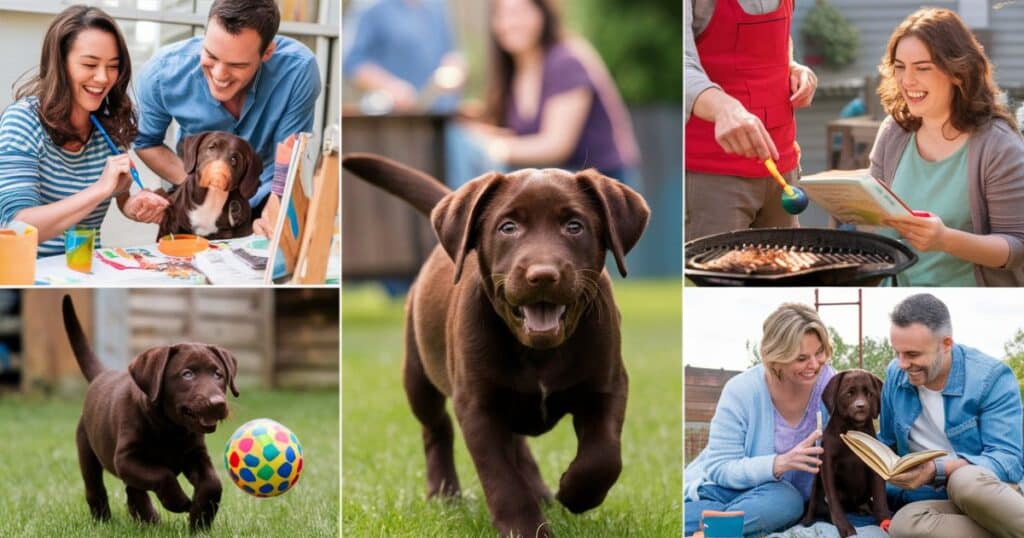
Chocolate Labs are known for their boundless energy, curiosity and zest for life. Having an arsenal of fun activities up your sleeve is key for keeping their minds and bodies engaged while deepening that beloved human-canine bond.
Let’s Get Moving: Unleashing Your Chocolate Lab’s Inner Olympian
As retrieving breeds, chocolate Labs thrive on physical activity and exercise. Here are some top picks to get their hearts racing:
🏊🏻♀️ Swimming – Most Labs take to the water like fuzzy little fish! Swimming builds endurance while being low-impact.
🐾 Hiking – Explore new trails and tap into their powerful senses of smell and adventure. Be sure to work up to longer distances.
🎾 Fetch – A classic game that provides a controlled outlet for their natural retrieving instincts. Use two different toys to keep it going!
🤸🏽♀️ Dog Sports – Look into local clubs for fun sports like agility, flyball, dock diving and more to challenge their minds and bodies.
🏃🏻♂️ Running/Biking – After they’re fully grown, chocolate Labs make excellent jogging or cycling buddies to help you both stay fit.
Besides burning energy, these activities provide vital mental stimulation and outlets for natural behaviors like sniffing, retrieving and exploring.
The Heart of the Matter: It’s All About That Bond
While physical exercise is important, the true essence of owning a chocolate Lab lies in the profoundly deep emotional bond you’ll develop. Here are some relationship-building activities:
📚 Training Games : Positive reinforcement training strengthens communication and creates a team mentality.
🛋 Cuddle Time : Labs thrive on affection! Snuggle sessions build trust and a sense of security.
📺 TV Dates : If you can’t resist those puppy dog eyes, indulge in some Netflix nights cuddled up together.
🛀 Bathtime : Making baths low-stress helps them associate grooming activities with quality time.
🥘 Lickable Treat Toys : Stuff a puzzle toy to work their brains while rewarding their patience.
As you can see, most of the best bonding moments for Labs involve including them in your daily life and routine. That companionship is truly what they live for.
Quickie Tips for Bonding Like a Pro
- Talk to your pup in an upbeat, friendly tone
- Make long eye contact to reinforce your connection
- Play fun reward-based games like Hide & Seek
- Take them on adventures to new sights and smells
- Consider getting a second chocolate Lab for company
- Be patient, loving and consistent in your interactions
- End activities before they get overly tired or bored
If you make an effort to integrate your chocolate Lab into your life as part of the family, you’ll reap the rewards of that unbreakable loyalty and love they’re so famous for.
Navigating the Adolescence of Chocolate Lab Puppies
Just like human teenagers, chocolate Lab adolescents can sometimes seem like completely different beings from their puppy selves! This awkward phase brings new challenges and behaviors.
Teenage Drama Unleashed: Surviving Your Lab’s Awkward Years
Around 6-18 months old, your once perfectly obedient chocolate Lab puppy may start pushing boundaries and exhibiting classic teenage antics like:
✦ Easily distracted/selective hearing
✦ Excessive chewing and mouthing
✦ Bouts of hyper, “zoomie” energy
✦ Bouts of stubborn defiance
✦ Increased barking and vocalization
✦ Testing rules or ignoring commands they know
Don’t worry – this trying phase is just your Lab’s way of establishing independence and individuality! It’s totally normal and natural.
The Real Deal: How to Tackle These Tantrums
While the teenage years can be frustrating, with patience and the right techniques, you can stay in control and keep guiding your Lab into a well-adjusted adult:
➡️ Keep Reinforcing Training : Be persistent about continuing obedience practice, despite their short attention span. Use higher value rewards.
➡️ Allow Constructive Chewing : Provide plenty of approved chewinglogs and toys to satisfy the urge appropriately.
➡️ Ramp Up Exercise ; All that restless energy needs a positive outlet, so prioritize vigorous play and workout sessions.
➡️ Be Calm and Consistent : Respond to teenage testingwith quiet confidence. Don’t shout or punish, it’ll only breed more defiance.
➡️ Update Household Rules : If needed, reinforce rules like not letting them on furniture now that they’re bigger.
➡️ Increase Mental Stimulation : Keep their inquisitive brains occupied with new tricks, puzzle toys and activities.
➡️ Baby-proof (again!) ::Do a household sweep for new temptations so you can Lab-proof accordingly.
With structure, routine and your steadfast leadership to guide them, your chocolate Lab will emerge from the teenage phase as a brilliant, loyal companion.
Joining the Community of Chocolate Lab Enthusiasts
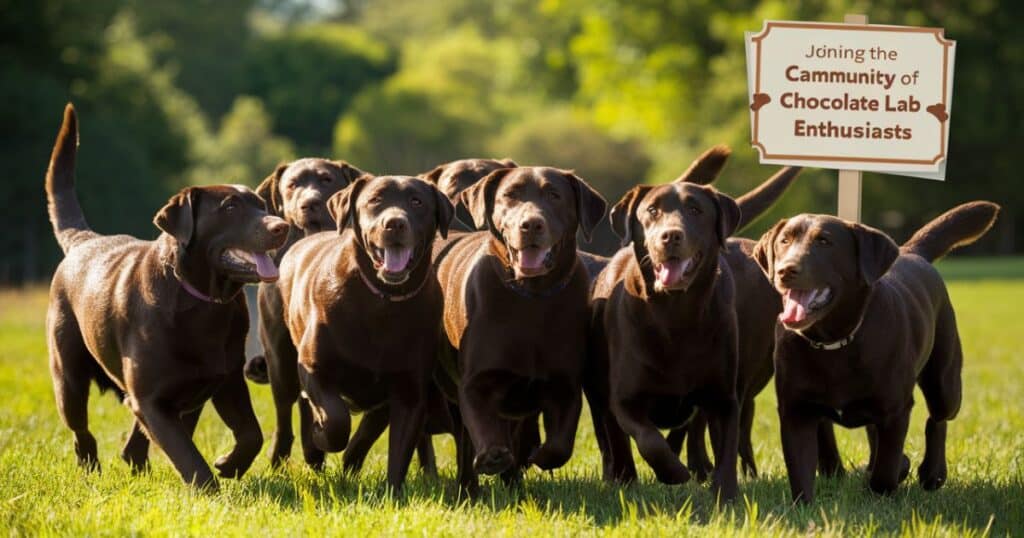
Owning a chocolate Lab instantly makes you part of an exclusive, passionate community of dog lovers worldwide. Why would you want to join?
Welcome to the Club: Why Being a Chocolate Lab Owner is Special
Beyond the intrinsic joys of owning one of these remarkable dogs, there are so many incredible benefits to being part of the chocolate Lab community:
👐 Finding Your Tribe: These are people who simply “get” the quirks and characteristics of chocolate Labs. Instant camaraderie!
🧭 Guidance and Mentorship : More experienced owners provide invaluable tips, training advice and know the best local resources.
👯♀️ Playdates and Puppy Pals : Your Lab can socialize with their own kind while you widen your circle of like-minded friends.
🤼♂️Athletic Endeavors : Competitive events and dog sport clubs let your Lab’s talents shine while you meet new training buddies.
💯 Being Part of Something Bigger : Many Lab lover groups organize fundraisers and charity events to give back.
🎡 Fun Social Events : From dog-friendly brewery nights to beach pawties, the social calendar stays packed!
When you share an affinity for and bond with such a special breed, it’s only natural to want to surround yourself with others who share that passion.
Get Social, the Chocolate Lab Way!
Ready to dive into the world of chocolate Lab socializing? Here’s a checklist to get started:
✔️ Search Facebook and Meetup for local, regional and national Lab lover groups to join
✔️ Ask your vet, groomer or dog walker about any Lab-specific events or connections
✔️ Check for breed-specific training clubs, dog sport leagues or competitive events to join
✔️ Attend fun community fundraisers or “yappy hours” hosted by Lab rescue organizations
✔️ Be an active member! Don’t just join groups – post pics, chime in on discussions and ask questions
✔️ Offer to help organize events, meetups, donation drives or charity efforts to get more involved
✔️ When you meet new Lab lovers out and about, get their info to grow your network
The more you immerse yourself in this welcoming community, the more enriching connections you’ll make for you and your four-legged friend.
Debunking Common Myths About Chocolate Lab Puppies
As one of the most popular dog breeds around, there’s no shortage of misinformation and misunderstandings floating around about chocolate Labrador Retrievers. It’s time to separate fact from fiction.
Myths That Need a Reality Check
Let’s tackle some of the most common myths about these beloved pups head-on:
📌 Myth: Chocolate Labs are dumb, hyper or aggressive
Truth: Their temperament depends on proper training, exercise and socialization – not their coat color.
📌 Myth: Chocolate is just a fancy “designer” color
Truth: This natural variation has existed for over a century due to genetics, not selective breeding gimmicks.
📌 Myth: Chocolates are unhealthier than other Labs
Truth: With reputable breeders, labs of all colors tend to have similar health profiles within the breed standard.
📌 Myth: Chocolates don’t make good service/working dogs
Truth: With the right training, they excel as guide dogs, search and rescue, therapy dogs and more.
The Truth Serum: What You Really Need to Know
Now that we’ve busted some of the biggest chocolate Lab myths wide open, let’s dive into the facts every owner should know:
✔️ The chocolate coat color is the result of two recessive genes, making these Labs relatively rare compared to their black and yellow counterparts.
✔️ Despite being less common, reputable breeders aim to produce litters with excellent temperaments, trainability and health across all coat colors.
✔️ When you get a chocolate Lab from a responsible breeder who does proper health and genetic testing, they are no more prone to issues like hip/elbow dysplasia, eye problems or cancers than other Labs.
✔️ Their stunning coat color has zero impact on their ability to serve as service dogs, search and rescue K9s, therapy dogs or excel in dog sports. It all comes down to proper training and socialization.
✔️ Chocolate Labs do tend to have a slightly slower metabolism, so portion control is important to prevent excess weight gain. But their exercise and nutrition needs are otherwise just like other Labs.
The key takeaway?
A chocolate Labrador’s coat color is simply a cosmetic trait; their wonderful temperaments, versatility and abilities are what truly allow them to shine as outstanding companions and workers.
Quick Tips for Myth-Busting Like a Pro
When you inevitably encounter chocolate Lab myths and misconceptions from others, you can respectfully correct them with these tips:
- Cite reputable sources or expertise like veterinarians, trainers and breed historians to back up the facts.
- Use real-world examples of amazing chocolate Labs excelling as service dogs, athletes, etc. to counteract biases.
- Encourage people to meet and interact with well-trained chocolate Labs to experience their stellar dispositions firsthand.
- Recommend ethical sources for more education, like lab breed club websites, expert books and online communities.
- Keep your cool and avoid getting heated – gently inspire understanding rather than fanning flames of ignorance.
With knowledge and patience, you can be an ambassador helping to spread accurate information about these exceptional dogs.
Preparing Your Chocolate Lab Puppy for the Golden Years
From tiny fluffball to beloved lifelong friend, your chocolate Lab’s needs will evolve as they reach their golden years. Here’s how to prepare:
The Golden Ticket: How to Ace Your Chocolate Lab’s Senior Life
As your Lab starts showing their age around 7-10 years old, you’ll likely notice some key changes:
- Slowing down with less stamina
- Loss of muscle tone and weight fluctuations
- Graying around the face/muzzle
- Potential vision/hearing impairment
- Higher Cancer Risk
- Possible cognitive decline
However, with some simple adjustments and added care, you can keep your senior chocolate Lab feeling youthful for as long as possible.
The Golden Age: Getting Ready for What’s Ahead
These proactive steps can help make your chocolate Lab’s twilight years healthy, comfortable and full of cherished moments:
🐾 Mobility Support – Ramps, orthopedic beds and anti-slip floors can provide comfort and safety as they slow down.
🍲 Dietary Adjustments – Switch to a low-calorie, high-fiber diet tailored for seniors and add joint supplements.
🏋️♀️ Low-Impact Exercise – Swimming, short leashed walks and gentle playtime keep them active without stressing aging joints.
👓 Regular Vet Visits – Don’t miss annual exams to catch issues like weight fluctuations or cognitive decline early.
🧠 Brain Games – Puzzle toys, food dispensing games and new tricks help keep their minds sharp.
🧼 Grooming Assistance – Professional groomers can help keep their coats tidy if they can no longer groom themselves properly.
With some simple changes and a little extra TLC, your chocolate Lab can live out their golden years in comfort and grace.
In Memoriam – Celebrating the Life of Your Chocolate Lab
The hardest part of sharing your life with a chocolate Labrador Retriever is someday having to say goodbye. When that inevitable day comes, celebrating their life and legacy can provide closure and healing.
Saying Goodbye, But Keeping the Memories Alive
Grieving such a profound loss is never easy, but always remember – it’s a reflection of the incredible bond you shared and sacrificed so much for. Remind yourself that you gave your chocolate Lab the best life imaginable.
As you navigate the emotional maze of grief, consider preserving those priceless memories in tangible ways:
💽 Create a memorial video slideshow of your favorite photos set to music
🖼 Commission a custom painted portrait of your Lab
☘️ Plant a memorial tree or garden with a plaque
👣 Order a clay paw print cast to cherish those little toe beans forever
✍️ Write down or record all your amazing stories and tales to pass down
Keepsakes like these can be profoundly healing, allowing you to hold onto your chocolatey best friend as you slowly recover from their absence.
Coping Corner: How to Heal While Holding On
The grieving process is deeply personal, but many find these outlets to be therapeutic:
💬 Join an online grief support group to share stories and your journey
💻 Make a social media album celebrating your Lab’s happiest memories
🐕 Foster or help walk dogs at a local shelter/rescue to stay connected
🏞 Take solitary walks at places your Lab loved to feel close to their spirit
Be patient and compassionate with yourself as you grieve. Lost love this profound is never easy to overcome.
But by celebrating and memorializing your chocolate Lab’s remarkable life and impact, you’ll gradually heal while keeping their spirit alive in your heart forever.
Top 3 Unique Facts About Chocolate Labradors
- They’re Genetically Rare The gorgeous chocolate coat color in Labradors is the result of two parents passing on a very rare, recessive gene. Only about 10-15% of all Lab litters produce chocolate pups!
- Chocolate Labradors May Be Less Healthy
Unfortunately, some research has linked the chocolate gene to a higher risk of skin and ear issues like hot spots and infections in Labs with this coat color. - They May Not Be as Trainable as Other Labs While still extremely intelligent, there’s some evidence that chocolate Labs can be slightly more stubborn and easily distracted than their black and yellow counterparts during training sessions.
Does a Chocolate Labrador Make a Good Pet?
Despite those few unique traits, chocolate Labradors absolutely make fantastic family companions when acquired from a reputable breeder and given proper training, socialization and care. Their laidback but energetic temperaments, unwavering loyalty and affection for their humans make them quintessential people-pleasers in the Labrador breed.
With the right owner providing plenty of exercise, mental stimulation and a structured routine, a well-bred chocolate Lab can indeed thrive as an outstanding lifelong pet. Their stunning coat color is just the icing on an already remarkable dog!
Conclusion – The Unbreakable Bond with Your Chocolate Lab Puppy
Whether you get your chocolate Lab puppy from an ethical breeder or open your heart and home through adoption, one thing is certain – your life is about to change in the most profound, heartwarming ways.
The Unbreakable Connection: Wrapping Up the Chocolate Lab Journey
From their first few wobbly weeks in your home as newborn fluffballs, all the way through adolescence, the prime of their lives, and those cherished golden years, chocolate Labs have an unparalleled way of burrowing into our hearts.
These are dogs that live and breathe to receive our love and affection, repaying that devotion a million times over with their unwavering loyalty, playful spirits, and endearing antics. They crave our companionship above all else, and thrive on being included as part of the family pack.
As you’ve learned, caring for a chocolate Lab is no easy feat. It requires immense commitment, patience, and a willingness to put their needs first through every stage of life. But for those who embrace the challenge, the payoff is a profound, soulful connection that transcends the traditional bonds of pet ownership.
Life Lessons from Your Chocolate Lab
Along this journey, your remarkable chocolate Lab will teach you invaluable lessons that extend far beyond the world of dogs:
💗 Unwavering Loyalty – Their devotion knows no bounds once you’ve earned their unconditional love and trust.
🌱 Living in the Moment – With their zest for life and ability to find joy in simple pleasures, they’ll inspire you to stay present.
🏃♀️ Finding Balance – Chocolate Labs thrive with the right mix of activity, discipline, and affection – a recipe for wellness we’d all do well to emulate.
🤗 Companionship is Key – At their core, these are dogs who desperately crave partnership and quality time with their chosen humans.
☮️ Forgiveness is Liberating – No grudges, just ready acceptance and a chance to try again after every misstep.
As you reflect on your chocolate Lab’s life, you’ll realize their greatest legacy is the invaluable wisdom, resilience and capacity for unconditional love they inspired in you.
The Takeaway: More Than Just a Pet
In the end, a chocolate Labrador Retriever is far more than just another breed of dog. They represent the very essence of what it means to nurture, respect and cherish the human-animal bond in its truest form.
These forever puppies wrapped in that luxurious, velvety brown coat will perpetually melt your heart with their antics, soulful eyes and uncompromising need to make you happy. Their spirits, once inextricably woven into the fabric of your life, can never be replaced.
So shower your chocolate Lab with all the love, attention and wonderful adventures they deserve. For in return, they’ll gift you with companionship, laughter, treasured memories and an abiding appreciation for life’s simple joys that no amount of money could ever buy.
That unbreakable, mutual bond is what truly makes the chocolate Labrador Retriever one of the most remarkable, irreplaceable dogs to ever walk this earth and share our lives.
ALSO READ THIS POST: Mastiff Labrador Mix: The Ultimate Guide To Lovable Mastadors
FAQ’s
How rare is a chocolate labrador?
Chocolate Labradors are relatively rare, making up only about 10-15% of Labrador litters. This is because the chocolate coat color is caused by a rare, recessive gene that must be inherited from both parents.
What is the price of Labra dog in Pakistan?
The price of a Labrador Retriever puppy in Pakistan typically ranges from 30,000 to 80,000 Pakistani Rupees. The price can vary based on factors like breeder reputation, bloodlines, and whether the pup is show-quality or pet-quality.
Are chocolate Labradors good dogs?
Yes, chocolate Labradors make excellent family companions and working dogs, just like other Labrador colors. They are known for their friendly, energetic, and eager-to-please temperaments when properly trained and socialized.
How big does a chocolate Labrador grow?
Male chocolate Labradors typically grow to be 22-24 inches tall and weigh 65-80 pounds when fully grown. Females are slightly smaller, usually reaching 21-23 inches tall and weighing 55-70 pounds at maturity.
Do chocolate labs live long?
With proper care, chocolate Labradors have an average lifespan of 10-12 years, similar to other Labrador colors. Their lifespan can be influenced by factors like diet, exercise, genetic health conditions, and preventive veterinary care.
Which Colour Labrador is most expensive?
The rarest and most expensive Labrador Retriever color is typically the Silver Labrador, followed by the Charcoal Labrador. These unique shades are the result of selective breeding and can cost significantly more than standard black, yellow, or chocolate Labs.

Davin Connor is an experienced author with 3 years in pets writing. Known for concise, informative content, he shares expertise on pet care, behavior, and health through his engaging articles.
